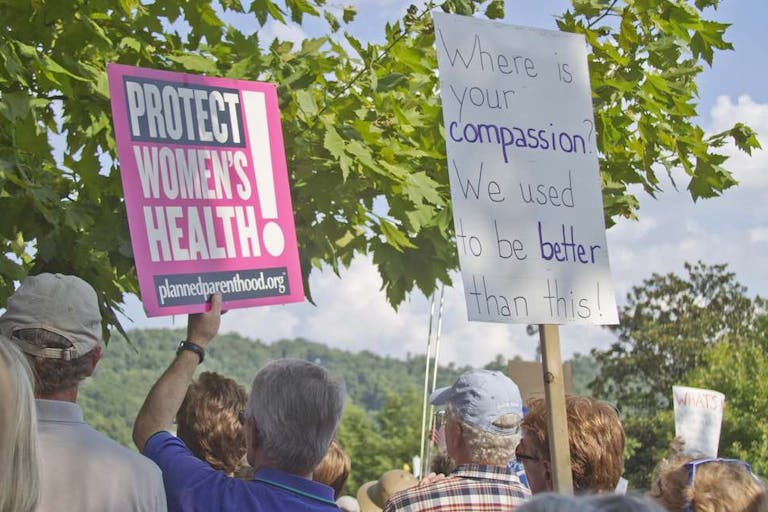
NICU babies are adorable in their 'ugly Christmas sweaters'
Nancy Flanders
·
Planned Parenthood’s plummeting health care services prove it’s not focused on women’s health
Planned Parenthood masquerades as a “health care organization” but data released from the organization’s 2018-2019 annual report calls this into question. The report makes clear that Planned Parenthood’s number one focus is abortion, and shows that it has increasingly garnered a massive amount of the total number of abortions committed in the U.S. (market share), committing the largest number of abortions on record in a single year in 2018. What the data also reveals is that Planned Parenthood serves only a small percentage of female clients in the U.S., and still performs less than one percent of the nation’s Pap tests and two percent of the nation’s breast cancer screenings (not mammograms).
Planned Parenthood serves an estimated three percent of women of reproductive age:
For years, Planned Parenthood has been propped up as a “women’s health” organization, yet it serves a very small percentage of female clients annually. Planned Parenthood reports show 2.4 million clients annually in 2015, 2016 , 2017 and again in 2018, despite declining nearly 23 percent (22.58%) from the 3.1 million it served in 2006, and 20 percent from the three million clients it claimed to serve just ten years ago (2008).
In contrast, between 2015 and 2018, federally qualified health centers (FQHC) – as identified by the federal Health Resources and Services Administration – serve tens of millions of women annually and have increased their patient load by nearly 17 percent (16.81%).
2015: FQHCs served 24,295,946, of which 20,616,149 were medical clients.
2016: FQHCs served 25,860,296, of which 21,880,295 were medical clients.
2017: FQHCs served 27,174,372, of which 22,866,468 were medical clients.
2018: FQHCs served 28,379,680 of which 23,827,122 were medical clients.
Planned Parenthood’s male clients are increasing. In 2014, Planned Parenthood reported serving more than 250,000 male patients. In 2018, a PP spokesperson told The Hill that men were “12 percent of the population that we serve.” In 2018, PP failed to break down the number of male and female clients in its report. However, based on the above data, we estimate:
288,000 were male.
2.1 million were female.
In contrast, out of the 28 million FQHC patients in 2018, 16,361,355 were female and 12,018,325 were male.
According to 2018 population data there were approximately 74,383,000 million women of reproductive age (15-49) in the U.S. This means that the most that PP could have served in 2018 was just three percent (.028) of the female population.
Planned Parenthood performs less than one percent of U.S. Pap tests:
Planned Parenthood performed 255,682 pap tests (cervical cancer screenings) in 2018 out of an estimated 29.5 million performed annually in the U.S. PP’s Pap tests decreased nearly seven percent (6.73%) from 274,145 in 2017 but have dropped 78 percent (78.40%) from a high of 1,183,692 in 2004.
In contrast:
2015: While PP recorded 293,799 Pap tests, FQHCs performed 1,863,957 cervical cancer screenings.
2016: While PP recorded 281,063 Pap tests, FQHCs performed 1,951,006 cervical cancer screenings.
2017: While PP recorded 274,145 Pap tests, FQHCs performed 1,853,912 cervical cancer screenings.
2018: While PP recorded 255,682 Pap tests, FQHCs performed 1,802,595 cervical cancer screenings.
According to a 2018 report published by the CDC, 69 percent of women aged 18 and over had a Pap test within the past three years. The number of physician office visits during which Pap tests were ordered or provided in 2016 was 22.6 million, according to an analysis by the National Ambulatory Medical Care. However, due to 2018 population data increases we estimate that Pap tests were closer to 29.5 million in 2018.
128,488,000 (females 18 and older) x 69% (88,656,720)/by three years = (29,552,240.)
PP’s share is 255,682/29,552,240 = .0086 x 100= .86% — less than one percent.
Planned Parenthood performs less than two percent of clinical (manual) breast exams.
PP reported performing 265,028 breast exams in 2018 out of approximately 20 million breast exams annually.
In contrast:
2015: While PP recorded 321,700 manual breast exams, FQHCs performed 521,568 mammograms.
2016: While PP recorded 336,614 manual breast exams, FQHCs performed 561,269 mammograms.
2017: While PP recorded 296,310 manual breast exams, FQHCs performed 724,187 mammograms.
2018: While PP recorded 265,028 manual breast exams, FQHCs performed 832,511 mammograms.
PP’s manual breast exams decreased nearly 11 percent (10.56%) from the 296,310 it reported in 2017, and dropped nearly 76 percent (75.61%) from a high of 1,086,654 in 2000. According to MammaCare.org, “Physicians and nurses perform clinical breast exams on an estimated 20 million U.S. women each year.”
This means that PP performs just 1.3% (.013) of breast exams nationally.
Planned Parenthood performs zero mammograms.
According to the CDC, 65.3 percent of women aged 40 and over had a mammogram within the past two years, and the number of physician office visits during which Pap tests were ordered or provided was 17.3 million, according to a 2016 analysis by the National Ambulatory Medical Care. However, Planned Parenthood does not own mammography machines, according to a medical device database updated weekly by the Federal Drug Administration’s list of certified mammography facilities (updated 1/6/2020), and performed zero mammograms in 2018.
Article continues below
Dear Reader,
In 2026, Live Action is heading straight where the battle is fiercest: college campuses.
We have a bold initiative to establish 100 Live Action campus chapters within the next year, and your partnership will make it a success!
Your support today will help train and equip young leaders, bring Live Action’s educational content into academic environments, host on-campus events and debates, and empower students to challenge the pro-abortion status quo with truth and compassion.
Invest in pro-life grassroots outreach and cultural formation with your DOUBLED year-end gift!
In contrast, as previously stated, FQHCs performed 832,511 mammograms in 2018.

Planned Parenthood provides less than one percent of prenatal care services in the U.S.:
Undercover investigations conducted by Live Action have revealed that abortion — not prenatal care — is the primary service Planned Parenthood offers to pregnant clients. While prenatal care at the corporation actually increased eight percent (8.20%) from 9,055 in 2017 to 9,798 in 2018 and nearly four percent (3.87%) in past ten years (9,433 in 2008 to 9,798 in 2018) — the service has dropped 68 percent (68.49%) from a high of 31,098 in 2010.
In contrast:
2015: While PP recorded 9,419 unspecified prenatal services, FQHCs served 552,150 prenatal patients.
2016: While PP recorded 7,762 unspecified prenatal services, FQHCs served 559,848 prenatal patients.
2017: While PP recorded 9,055 unspecified prenatal services, FQHCs served 573,026 prenatal patients.
2018: While PP recorded 9,798 prenatal services, FQHC’s served 563,740 prenatal patients.
There were 22.5 million prenatal visits in the U.S., according to a 2016 analysis by National Ambulatory Medical Care, which means that Planned Parenthood provides less than one percent (.0004%) of prenatal services in the U.S. — and as Live Action has previously shown, these are primarily referrals for care.
Planned Parenthood recently purged its websites of the term “prenatal” after Live Action’s Prenatal Deception Investigation, followed by our Ultrasounds Used for Killing Investigation, which showed that with few exceptions, the primary service Planned Parenthood offers to pregnant women is abortion.

Planned Parenthood commits 40 percent of U.S. abortions:
While abortions have been decreasing nationwide, abortions at Planned Parenthood are increasing. Live Action News has previously documented that:
Abortions nationwide have dropped 50 percent since 1980, according to the latest (2016) CDC report.
The U.S. abortion rate hit its lowest point since Roe v. Wade, according to (2017) Guttmacher data.
Abortions are declining nationally after topping more than 20 million since 2000.
In 2018, despite the drop in national abortion numbers, Planned Parenthood has scooped up more of the nation’s total abortions, committing 345,675 abortions of the 862,320 abortions reported by the Guttmacher Institute (2017) — the highest committed by the corporation in recent years. PP’s abortions have increased nearly four percent (3.88%) from 2017‘s 332,757 abortions, and 3.51% from 2011 (333,964). In the past several years, abortions at Planned Parenthood have risen nearly seven percent (6.67%) from 324,008 in 2008 to 345,672 in 2018.
As a result, PP now garners 40 percent of the abortion market share.

While Planned Parenthood is ratcheting up its abortion services and stacking up on “excess revenue,” it also inexplicably lost 400,000 donors in 2018. Live Action News previously documented, the corporation saw a nearly $53 million increase in taxpayer dollars, from $563.8 million (2017) to $616.8 million (highest amounts recorded in recent years) in 2018. And, since 2008, taxpayer dollars to Planned Parenthood have increased by nearly 70 percent (69.82%) from $363.2 million in 2008. This has resulted in PP taking in excess revenue of $110 million in 2018 — and PP’s net assets totaled nearly nearly $2 billion that year. Since 2000, despite PP’s steep decline in health services, it has managed to bring in over $1.5 BILLION in excess revenue.
Since 2010, Planned Parenthood has committed an average of 330,000 abortions every year. The corporation currently commits 81 abortions for every adoption and 35 abortions for every prenatal service referral. Tragically, Planned Parenthood now ends the lives of 947 preborn babies every day (39 per hour; one abortion every 91 seconds).
“Like” Live Action News on Facebook for more pro-life news and commentary!
Live Action News is pro-life news and commentary from a pro-life perspective.
Contact editor@liveaction.org for questions, corrections, or if you are seeking permission to reprint any Live Action News content.
Guest Articles: To submit a guest article to Live Action News, email editor@liveaction.org with an attached Word document of 800-1000 words. Please also attach any photos relevant to your submission if applicable. If your submission is accepted for publication, you will be notified within three weeks. Guest articles are not compensated (see our Open License Agreement). Thank you for your interest in Live Action News!

Nancy Flanders
·
Analysis
Cassy Cooke
·
Analysis
Cassy Cooke
·
Analysis
Cassy Cooke
·
Analysis
Cassy Cooke
·
Analysis
Nancy Flanders
·
Abortion Pill
Carole Novielli
·
Abortion Pill
Carole Novielli
·
Investigative
Carole Novielli
·
Abortion Pill
Carole Novielli
·
Investigative
Carole Novielli
·